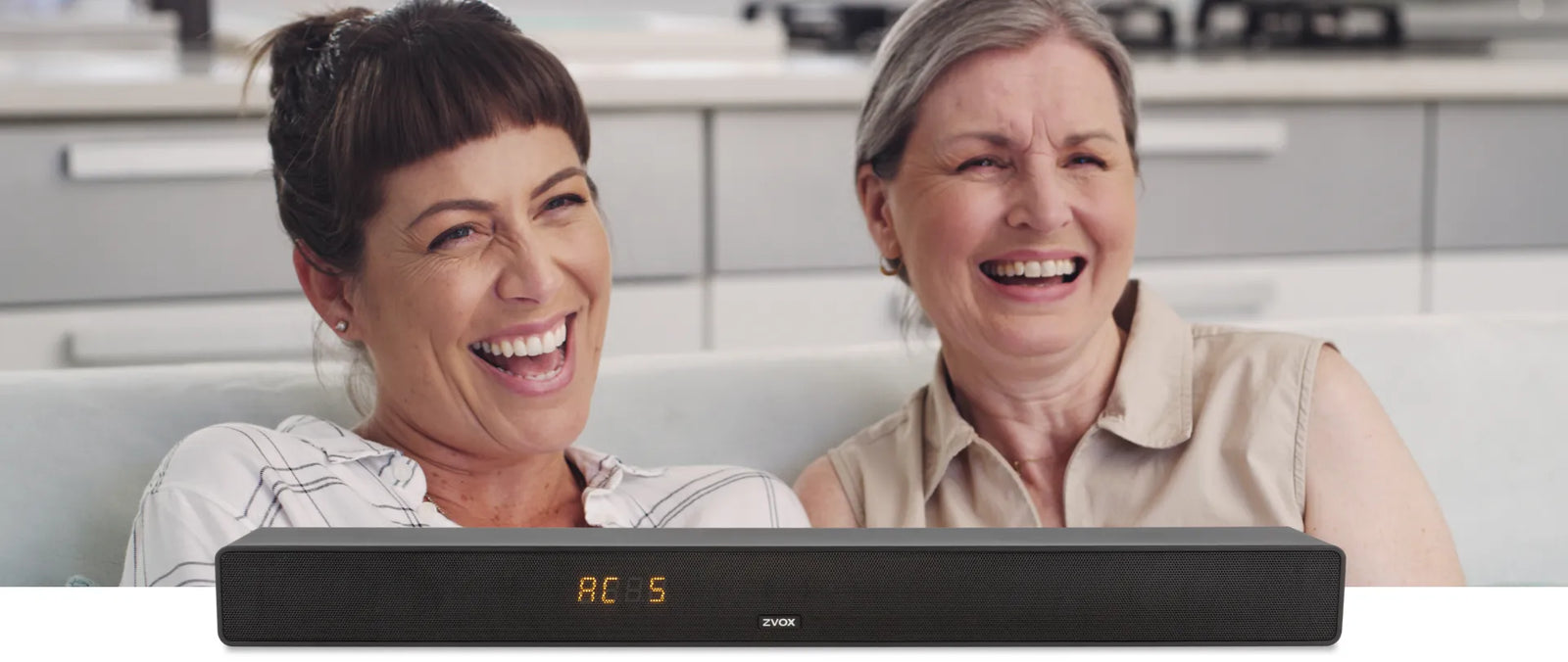Flat screen TVs use miniature speakers that garble dialogue. So millions can’t understand voices on TV broadcasts.
More and more people can’t understand dialogue on TV shows and movies – because Hollywood is experimenting too much with audio mixing techniques, because TV sound systems are worse than ever, and because 95 million people are over 50 years of age and have some degree of hearing impairment.
 Hollywood is using more adventurous audio mixing techniques – often resulting in unclear dialogue. Ann Hornaday of the Washington Post recently described a blockbuster Hollywood movie as having “a muddy, thuddingly loud sound design, in which the score and similarly thumping sound effects render spoken dialogue a submerged garble.” She’s not the only one complaining. Thousands of web articles in the last two years complain about soundtracks with muddled, hard-to-understand dialogue. From Downton Abbey to The Walking Dead to football announcers. It’s an epidemic.
Hollywood is using more adventurous audio mixing techniques – often resulting in unclear dialogue. Ann Hornaday of the Washington Post recently described a blockbuster Hollywood movie as having “a muddy, thuddingly loud sound design, in which the score and similarly thumping sound effects render spoken dialogue a submerged garble.” She’s not the only one complaining. Thousands of web articles in the last two years complain about soundtracks with muddled, hard-to-understand dialogue. From Downton Abbey to The Walking Dead to football announcers. It’s an epidemic.
TV manufacturers put very little effort or expense into TV speaker systems, often using half-inch speakers aimed downwards – or even backwards, away from the listener. The dark secret of TV manufacturers is that they don’t care about sound quality. For years TV designers have been in a market-share war, trying to outdo the competition with thinner, sleeker TVs…which simply aren’t big enough to hold good sound systems. The sound systems in most ultra high definition TVs – with tiny, downward-facing (or backward-facing) speakers – do not sound as good as the sound system in a 1952 Philco black and white TV. The ultra-small, poorly-aimed speakers in flat screen TVs are often incapable of reproducing human speech clearly and accurately. And the really bad news is that TVs are getting even thinner. The new generation of OLED TVs introduced at the January 2016 Consumer Electronics Show have screens as thin as three millimeters!
There are more people in the United States over 50 than ever before. Aging baby boomers – many of whom grew up going to Rolling Stones and Who concerts – have dramatically altered the demographic landscape. Over 95 million U.S. citizens are over 50*…and many of them inevitably have some degree of hearing loss. Combine the above three factors and the result is that huge numbers of people are finding it increasingly difficult to understand dialogue on television broadcasts.
So what’s the solution? Conventional hearing aids don’t solve the problem because they can’t improve TV sound. They just let people hear bad TV sound more clearly.

Systems that send a TV’s audio signal directly to a person’s hearing aids can solve the problem. But such technology can be expensive. And this solution does not address a key group – people with marginal hearing impairment who do not use hearing aids.
Home theater sound systems are much better than the speakers built into TVs. But they are often complicated and expensive. And simpler, more affordable sound bars often don’t employ center speakers – crucial for accurate dialogue reproduction. Plus many sound bars include boomy subwoofers which actually interfere with voice clarity.
A new category of product – home theater sound systems with dialogue enhancement – are a good solution for many people. Some of these products simply add a center speaker to the sound bar. Others manipulate equalization to highlight dialogue, with or without the addition of a center speaker. A new product by ZVOX, the AccuVoice TV Speaker, uses advanced algorithms that isolate the “consonant frequencies” that are they key to speech clarity. The system literally lifts the voices out of the background soundtrack, and brings them forward by compressing and amplifying and manipulating them electronically. A key ingredient of this proprietary, patented technology (U.S. Patent 9,747,923 B2) is that it is applied only to voices that are detected in the soundtrack. We believe this new product sets new standards for performance for the category of dialogue enhancing speakers.
Garbled TV sound is a big problem for millions of people. We believe dialogue enhancing speakers could outsell home theater systems in just a few years.
* 2010 U.S. Census data.






